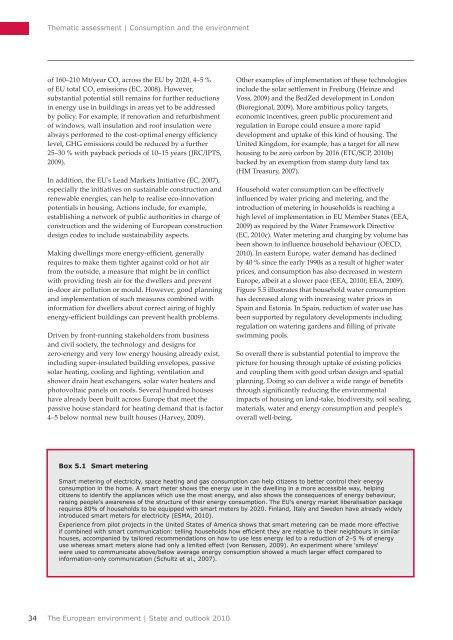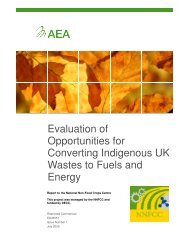Consumption and the environment (SOER2010) - European ...
Consumption and the environment (SOER2010) - European ...
Consumption and the environment (SOER2010) - European ...
You also want an ePaper? Increase the reach of your titles
YUMPU automatically turns print PDFs into web optimized ePapers that Google loves.
Thematic assessment | <strong>Consumption</strong> <strong>and</strong> <strong>the</strong> <strong>environment</strong><br />
of 160–210 Mt/year CO 2<br />
across <strong>the</strong> EU by 2020, 4–5 %<br />
of EU total CO 2<br />
emissions (EC, 2008). However,<br />
substantial potential still remains for fur<strong>the</strong>r reductions<br />
in energy use in buildings in areas yet to be addressed<br />
by policy. For example, if renovation <strong>and</strong> refurbishment<br />
of windows, wall insulation <strong>and</strong> roof insulation were<br />
always performed to <strong>the</strong> cost-optimal energy efficiency<br />
level, GHG emissions could be reduced by a fur<strong>the</strong>r<br />
25–30 % with payback periods of 10–15 years (JRC/IPTS,<br />
2009).<br />
In addition, <strong>the</strong> EU's Lead Markets Initiative (EC, 2007),<br />
especially <strong>the</strong> initiatives on sustainable construction <strong>and</strong><br />
renewable energies, can help to realise eco-innovation<br />
potentials in housing. Actions include, for example,<br />
establishing a network of public authorities in charge of<br />
construction <strong>and</strong> <strong>the</strong> widening of <strong>European</strong> construction<br />
design codes to include sustainability aspects.<br />
Making dwellings more energy-efficient, generally<br />
requires to make <strong>the</strong>m tighter against cold or hot air<br />
from <strong>the</strong> outside, a measure that might be in conflict<br />
with providing fresh air for <strong>the</strong> dwellers <strong>and</strong> prevent<br />
in-door air pollution or mould. However, good planning<br />
<strong>and</strong> implementation of such measures combined with<br />
information for dwellers about correct airing of highly<br />
energy-efficient buildings can prevent health problems.<br />
Driven by front-running stakeholders from business<br />
<strong>and</strong> civil society, <strong>the</strong> technology <strong>and</strong> designs for<br />
zero‐energy <strong>and</strong> very low energy housing already exist,<br />
including super-insulated building envelopes, passive<br />
solar heating, cooling <strong>and</strong> lighting, ventilation <strong>and</strong><br />
shower drain heat exchangers, solar water heaters <strong>and</strong><br />
photovoltaic panels on roofs. Several hundred houses<br />
have already been built across Europe that meet <strong>the</strong><br />
passive house st<strong>and</strong>ard for heating dem<strong>and</strong> that is factor<br />
4–5 below normal new built houses (Harvey, 2009).<br />
O<strong>the</strong>r examples of implementation of <strong>the</strong>se technologies<br />
include <strong>the</strong> solar settlement in Freiburg (Heinze <strong>and</strong><br />
Voss, 2009) <strong>and</strong> <strong>the</strong> BedZed development in London<br />
(Bioregional, 2009). More ambitious policy targets,<br />
economic incentives, green public procurement <strong>and</strong><br />
regulation in Europe could ensure a more rapid<br />
development <strong>and</strong> uptake of this kind of housing. The<br />
United Kingdom, for example, has a target for all new<br />
housing to be zero carbon by 2016 (ETC/SCP, 2010b)<br />
backed by an exemption from stamp duty l<strong>and</strong> tax<br />
(HM Treasury, 2007).<br />
Household water consumption can be effectively<br />
influenced by water pricing <strong>and</strong> metering, <strong>and</strong> <strong>the</strong><br />
introduction of metering in households is reaching a<br />
high level of implementation in EU Member States (EEA,<br />
2009) as required by <strong>the</strong> Water Framework Directive<br />
(EC, 2010c). Water metering <strong>and</strong> charging by volume has<br />
been shown to influence household behaviour (OECD,<br />
2010). In eastern Europe, water dem<strong>and</strong> has declined<br />
by 40 % since <strong>the</strong> early 1990s as a result of higher water<br />
prices, <strong>and</strong> consumption has also decreased in western<br />
Europe, albeit at a slower pace (EEA, 2010f; EEA, 2009).<br />
Figure 5.5 illustrates that household water consumption<br />
has decreased along with increasing water prices in<br />
Spain <strong>and</strong> Estonia. In Spain, reduction of water use has<br />
been supported by regulatory developments including<br />
regulation on watering gardens <strong>and</strong> filling of private<br />
swimming pools.<br />
So overall <strong>the</strong>re is substantial potential to improve <strong>the</strong><br />
picture for housing through uptake of existing policies<br />
<strong>and</strong> coupling <strong>the</strong>m with good urban design <strong>and</strong> spatial<br />
planning. Doing so can deliver a wide range of benefits<br />
through significantly reducing <strong>the</strong> <strong>environment</strong>al<br />
impacts of housing on l<strong>and</strong>-take, biodiversity, soil sealing,<br />
materials, water <strong>and</strong> energy consumption <strong>and</strong> people's<br />
overall well-being.<br />
Box 5.1 Smart metering<br />
Smart metering of electricity, space heating <strong>and</strong> gas consumption can help citizens to better control <strong>the</strong>ir energy<br />
consumption in <strong>the</strong> home. A smart meter shows <strong>the</strong> energy use in <strong>the</strong> dwelling in a more accessible way, helping<br />
citizens to identify <strong>the</strong> appliances which use <strong>the</strong> most energy, <strong>and</strong> also shows <strong>the</strong> consequences of energy behaviour,<br />
raising people's awareness of <strong>the</strong> structure of <strong>the</strong>ir energy consumption. The EU's energy market liberalisation package<br />
requires 80% of households to be equipped with smart meters by 2020. Finl<strong>and</strong>, Italy <strong>and</strong> Sweden have already widely<br />
introduced smart meters for electricity (ESMA, 2010).<br />
Experience from pilot projects in <strong>the</strong> United States of America shows that smart metering can be made more effective<br />
if combined with smart communication: telling households how efficient <strong>the</strong>y are relative to <strong>the</strong>ir neighbours in similar<br />
houses, accompanied by tailored recommendations on how to use less energy led to a reduction of 2–5 % of energy<br />
use whereas smart meters alone had only a limited effect (von Renssen, 2009). An experiment where 'smileys'<br />
were used to communicate above/below average energy consumption showed a much larger effect compared to<br />
information-only communication (Schultz et al., 2007).<br />
34<br />
The <strong>European</strong> <strong>environment</strong> | State <strong>and</strong> outlook 2010








